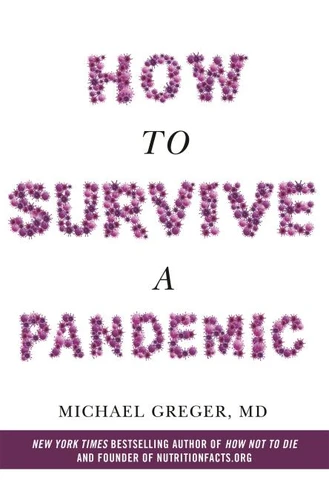
How to Survive a Pandemic
Par :Formats :
Disponible dans votre compte client Decitre ou Furet du Nord dès validation de votre commande. Le format ePub protégé est :
- Compatible avec une lecture sur My Vivlio (smartphone, tablette, ordinateur)
- Compatible avec une lecture sur liseuses Vivlio
- Pour les liseuses autres que Vivlio, vous devez utiliser le logiciel Adobe Digital Edition. Non compatible avec la lecture sur les liseuses Kindle, Remarkable et Sony
- Non compatible avec un achat hors France métropolitaine
 , qui est-ce ?
, qui est-ce ?Notre partenaire de plateforme de lecture numérique où vous retrouverez l'ensemble de vos ebooks gratuitement
Pour en savoir plus sur nos ebooks, consultez notre aide en ligne ici
- Nombre de pages592
- FormatePub
- ISBN978-1-5290-5490-3
- EAN9781529054903
- Date de parution26/05/2020
- Protection num.Adobe DRM
- Infos supplémentairesepub
- ÉditeurBluebird
Résumé
A vital, timely text on the viruses that cause pandemics and how to face them, by the New York Times bestselling author of How Not to Die. As the world grapples with the devastating impact of COVID-19, Dr Michael Greger reveals not only what we can do to protect ourselves and our loved ones during a pandemic, but also what human society must rectify to reduce the likelihood of even worse catastrophes in the future.
From tuberculosis to bird flu and HIV to coronavirus, these infectious diseases share a common origin story: human interaction with animals. Otherwise known as zoonotic diseases for their passage from animals to humans, these pathogens - both pre-existing ones and those newly identified - emerge and re-emerge throughout history, sparking epidemics and pandemics that have resulted in millions of deaths around the world.
How did these diseases come about? And what - if anything - can we do to stop them and their fatal march into our countries, our homes, and our bodies? In How to Survive a Pandemic, Dr Michael Greger, physician and internationally-recognized expert on public health issues, delves into the origins of some of the deadliest pathogens the world has ever seen. Tracing their evolution from the past until today, Dr Greger spotlights emerging flu and coronaviruses as he examines where these pathogens originated, as well as the underlying conditions and significant human role that have exacerbated their lethal influence to large, and even global, levels.
From tuberculosis to bird flu and HIV to coronavirus, these infectious diseases share a common origin story: human interaction with animals. Otherwise known as zoonotic diseases for their passage from animals to humans, these pathogens - both pre-existing ones and those newly identified - emerge and re-emerge throughout history, sparking epidemics and pandemics that have resulted in millions of deaths around the world.
How did these diseases come about? And what - if anything - can we do to stop them and their fatal march into our countries, our homes, and our bodies? In How to Survive a Pandemic, Dr Michael Greger, physician and internationally-recognized expert on public health issues, delves into the origins of some of the deadliest pathogens the world has ever seen. Tracing their evolution from the past until today, Dr Greger spotlights emerging flu and coronaviruses as he examines where these pathogens originated, as well as the underlying conditions and significant human role that have exacerbated their lethal influence to large, and even global, levels.
A vital, timely text on the viruses that cause pandemics and how to face them, by the New York Times bestselling author of How Not to Die. As the world grapples with the devastating impact of COVID-19, Dr Michael Greger reveals not only what we can do to protect ourselves and our loved ones during a pandemic, but also what human society must rectify to reduce the likelihood of even worse catastrophes in the future.
From tuberculosis to bird flu and HIV to coronavirus, these infectious diseases share a common origin story: human interaction with animals. Otherwise known as zoonotic diseases for their passage from animals to humans, these pathogens - both pre-existing ones and those newly identified - emerge and re-emerge throughout history, sparking epidemics and pandemics that have resulted in millions of deaths around the world.
How did these diseases come about? And what - if anything - can we do to stop them and their fatal march into our countries, our homes, and our bodies? In How to Survive a Pandemic, Dr Michael Greger, physician and internationally-recognized expert on public health issues, delves into the origins of some of the deadliest pathogens the world has ever seen. Tracing their evolution from the past until today, Dr Greger spotlights emerging flu and coronaviruses as he examines where these pathogens originated, as well as the underlying conditions and significant human role that have exacerbated their lethal influence to large, and even global, levels.
From tuberculosis to bird flu and HIV to coronavirus, these infectious diseases share a common origin story: human interaction with animals. Otherwise known as zoonotic diseases for their passage from animals to humans, these pathogens - both pre-existing ones and those newly identified - emerge and re-emerge throughout history, sparking epidemics and pandemics that have resulted in millions of deaths around the world.
How did these diseases come about? And what - if anything - can we do to stop them and their fatal march into our countries, our homes, and our bodies? In How to Survive a Pandemic, Dr Michael Greger, physician and internationally-recognized expert on public health issues, delves into the origins of some of the deadliest pathogens the world has ever seen. Tracing their evolution from the past until today, Dr Greger spotlights emerging flu and coronaviruses as he examines where these pathogens originated, as well as the underlying conditions and significant human role that have exacerbated their lethal influence to large, and even global, levels.











